AMD + ITX + TB3? It's the ASRock X570 Phantom Gaming-ITX/TB3 Motherboard Review
by Gavin Bonshor on October 9, 2019 12:00 PM ESTBIOS
ASRock's firmware is generally consistent with its GUI across its motherboard range and the ASRock X570 Phantom Gaming-ITX/TB3. The X570 Phantom Gaming-ITX/TB3 is using its Phantom Gaming firmware which includes a primarily black background with red gaming themed accents, with white text and grey highlights. Rather than splitting the firmware into two main sections, the firmware on this model has one primary mode. Everything in relation to overclocking, even minor tweaks can be found within the OC Tweaker section.
Upon entering the BIOS for the first time, users will land on the Main section. This is a very minimalistic area which displays very basic information including the version of the firmware that is installed, information on the processor, and the capacity of the memory installed.
All of the boards overclocking related settings are handily located within the OC Tweaker menu. Users can overclock both the processor and memory with a whole range of tweakable and customizable options available. This includes settings like CPU Core Frequency, CPU VCore voltage, and the boards five different LLC profiles. For users looking to make more tweaks to memory rather than just enabling the X.M.P profile, the DRAM Timing Configuration menu allows users to make adjustments to primary, secondary, and tertiary latency timings. Below is a list of limitations when using the current firmware for settings such as CPU VCore, CPU frequency, DRAM frequency, and the Infinity Fabric/FCLK frequency. It should be noted that most of these maximum values won't even be able to be reached, even with extreme cooling methods:
- Maximum CPU Frequency = 6.375 GHz
- Maximum CPU VCore = 2.5 V
- Maximum DRAM Frequency = DDR4-6000
- Maximum Infinity Fabric/FCLK Frequency = 3000 MHz
The ASRock X570 Phantom Gaming-ITX/TB3 has just three 4-pin headers with one for a CPU fan, one for a CPU/Water pump, and for installation of a single chassis fan. As a result, the firmware hasn't got the usual FAN-Tastic tuning utility which we are used to seeing. Instead, users can moderately customize profiles within the H/W Monitor section with temperature and percentage variables. For better control, the ASRock Phantom Gaming utility which comes in the board's software bundle offers fan curve customization.
ASRock has opted to use a very archaic method of customizing its onboard RGB LEDs on the X570 Phantom Gaming-ITX/TB3. Going backwards on the firmware GUI, users can select between 13 different lighting modes, or turn them off completely. Again the software bundle comes to the rescue again with its ASRock Polychrome RGB utility.
I find it difficult saying this but firmware on the ASRock X570 Phantom Gaming-ITX/TB3 is impressive in some areas and completely lacklustre in others. Where we are used to seeing the decent FAN-Tastic fan tuning utility and a somewhat better method of controlling RGB LEDs within the firmware, we feel ASRock hasn't delivered in these areas. For overclockers, there are plenty of options and customizations which go far beyond current capabilities of current processors, and the settings for fine-tuning memory are on point. The only caveat really is for the more novice users looking to make quick and easy alterations, which the X570 Phantom Gaming-ITX/TB3 isn't catered for.
Software
Moving onto the software bundle supplied with the ASRock X570 Phantom Gaming-ITX/TB3, and it's pretty standard to what we've seen from other ASRock motherboards. The highlight of the software is ASRock's Phantom Gaming Utility, while the Live Update and App Shop software is also useful to have. Despite the lack of adequate RGB LED customization within the firmware, the ASRock Polychrome RGB software takes care of that.
ASRock’s Phantom Gaming Tuning software is consistent throughout its range of Phantom Gaming branded models, including across its AMD and Intel chipsets. The only differences from the Intel and AMD sides are the settings available. Users can use Phantom Gaming Tuning to overclock within Windows and tweak settings such as CPU VCore, CPU ratio, CPU cache ratio, and DRAM voltage. One thing users cannot do is customize the memory frequency which will have to be done in the BIOS.
Despite having three 4-pin fan headers available, the ASRock Phantom Gaming Tuning software includes the FAN-Tastic utility within. Users can customize based on fan curves, or with preset profiles such as full-speed, or even allow the software to tune the fans based on current temperatures.
Users can customize the integrated RGB LED strip at the bottom of the board or strips installed into the two headers via the ASRock Polychrome Sync software. The GUI is very user-friendly and ASRock allows you select different types of lighting effects including static, random, wave, and rainbow; there are fourteen different modes not including the ability to switch the RGB LEDs off altogether.
The ASRock App Shop is awash with unsavoury looking gambling apps which have been a mainstay since they released this application, but as it's been combined with the Live Update application too, it does serve a good purpose. Users can download and update the ASRock software applications, as well as keep important drivers up-to-date, as well as update the firmware to the latest version without having to use the tool within the firmware.
Like we have found with the majority of motherboards recently tested, vendors haven't included adequate audio software in with the bundle, or made readily available from the official product pages. The marketing materials for the ASRock X570 Phantom Gaming-ITX/TB3 mentions that it's supported with Creative Sound Blaster Cinema 5, but even adding a simple link for users to download this would make the overall experience better. The software bundled with the board is actually more than some users will need.



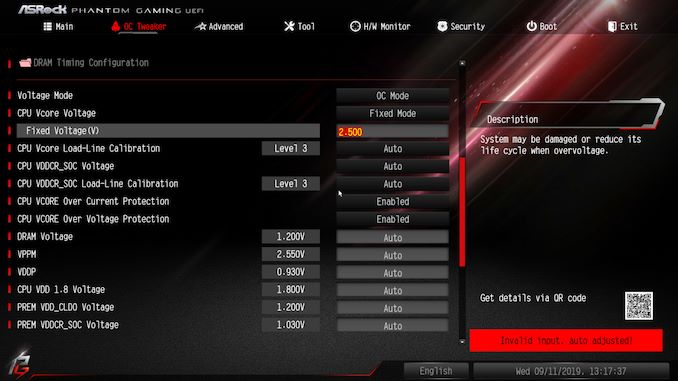
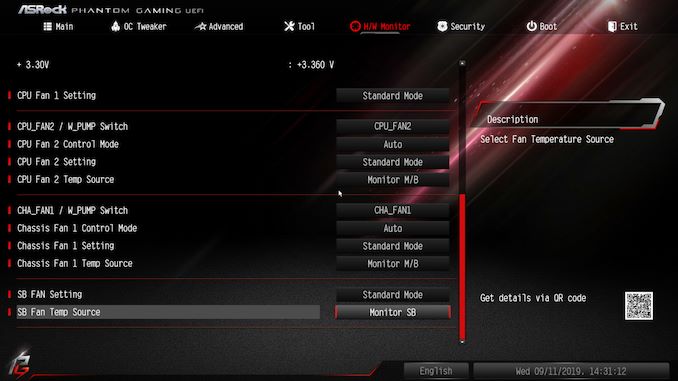
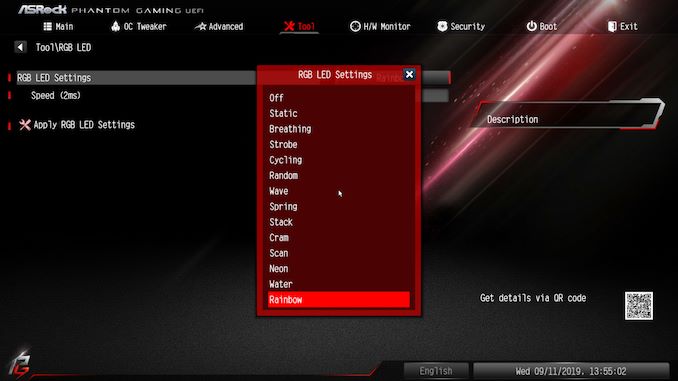






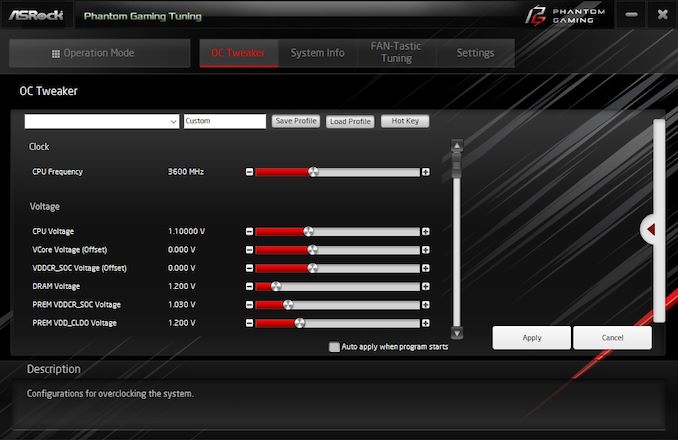
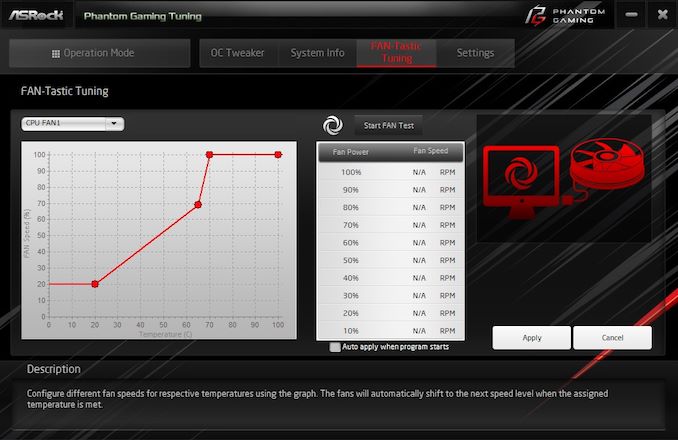

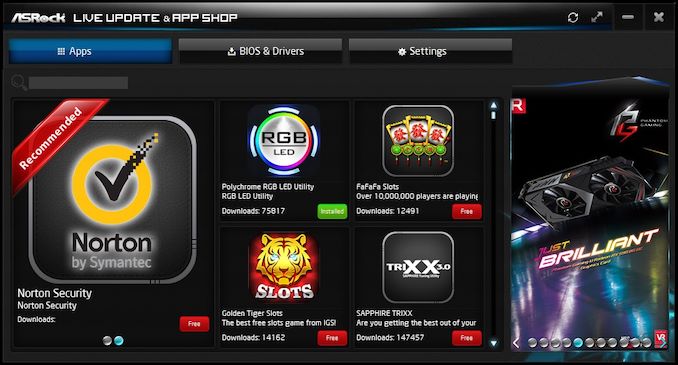














64 Comments
View All Comments
DanaGoyette - Thursday, October 10, 2019 - link
Would you mind checking out the PBO power meters? There are suspicions that the boards are reading 50% of the actual power usage.https://www.reddit.com/r/ASRock/comments/clbolc/x5...
DanaGoyette - Thursday, October 10, 2019 - link
Oops, wrong link.https://www.reddit.com/r/ASRock/comments/cx47ql/th...
yetanotherhuman - Thursday, October 10, 2019 - link
I remember the days of chipset fans. No thanks. I'd rather have a B450 board. (In fact, that's exactly what I bought for my 3600)Sivar - Tuesday, October 15, 2019 - link
Agreed. If there is one absolute rule I remember from so many years of building PCs, it's "No small fans allowed, especially non-serviceable fans on motherboards. No."Yes, fans have become better, but not so much as to violate the cardinal rule of motherboard choice.
Dug - Thursday, October 10, 2019 - link
I for one use TB3 everyday for external storage. Sense this is the highlight of the motherboard it would make sense to test it. Along with networking wireless/ wired, sound, usb, etc. You know, the stuff that is on the motherboard.eek2121 - Sunday, October 13, 2019 - link
IMO I am definitely for an M.2 boot drive + local storage, but I really wish for 6 sata ports or the ability to squeeze in an extra PCIEx4 slot so we can expand ourselves. You can fit a surprising amount of 2.5" hard drives in mini ITX case. I'm up to nearly 60 TB starting tomorrow.Nikit - Sunday, October 13, 2019 - link
To all of you longing for 10gbe or extra m.2 slot - this board supports 8x8 bifurcation of the 16x slot.umano - Monday, October 21, 2019 - link
thank youpeevee - Monday, October 14, 2019 - link
I am surprised to see that the default setting is actually overclock to the long-term unsafe levels (every time you raise the voltage you reduce the longevity AND power efficiency).kgreen747 - Saturday, November 30, 2019 - link
Why did they not utilize the 4 remaining PCIE lanes from the CPU to drive the TB3 chip or M.2 slot?